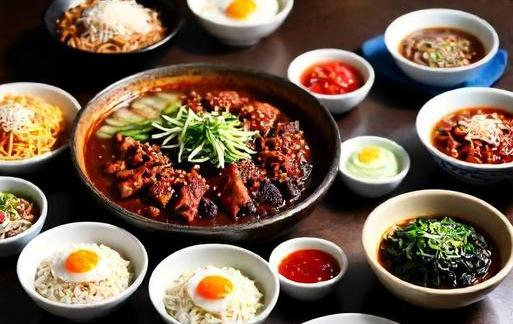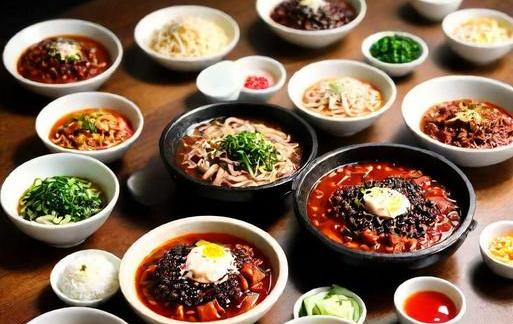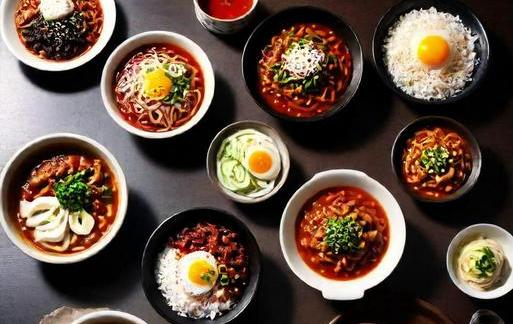- You are here:
- Home »
- Food
- » [REVEALED] Korean Foods That Start With S
[REVEALED] Korean Foods That Start With S
Note: This page contains affiliate links.
As an Amazon Associate, I earn from qualifying purchases when you click on the link, but you are not charged extra.
Korean cuisine is renowned for its rich flavors, diverse ingredients, and vibrant culinary traditions. From sizzling barbecue to spicy stews, Korean food has something to offer for every palate. In this article, we will delve into the world of Korean foods that start with the letter “S”. From beloved classics to hidden gems, these dishes showcase the unique blend of flavors and textures that define Korean gastronomy.
Contents
- 1 List Of Korean Foods That Start With S
- 1.1 1. Samgyeopsal (삼겹살) – Grilled Pork Belly
- 1.2 2. Sundubu-jjigae (순두부찌개) – Soft Tofu Stew
- 1.3 3. Ssambap (쌈밥) – Wrap Rice
- 1.4 4. Sikhye (식혜) – Sweet Rice Drink
- 1.5 5. Soondae (순대) – Blood Sausage
- 1.6 6. Saeujeot (새우젓) – Fermented Shrimp Sauce
- 1.7 7. Saengseon Jeon (생선전) – Pan-Fried Fish Pancake
- 1.8 8. Sujeonggwa (수정과) – Cinnamon Punch
- 1.9 9. Seolleongtang (설렁탕) – Ox Bone Soup
- 1.10 10. Sannakji (산낙지) – Live Octopus
- 2 Significance
- 3 Category-Related
- 4 Common Themes
- 5 Interesting Facts
- 6 Conclusion
List Of Korean Foods That Start With S

1. Samgyeopsal (삼겹살) – Grilled Pork Belly
Samgyeopsal, a staple of Korean barbecue, is a dish that showcases the art of grilling. Thin slices of pork belly are grilled at the table, creating a sensory experience that combines the enticing aroma of sizzling meat with the anticipation of a delicious meal. The grilled samgyeopsal is often accompanied by a variety of condiments such as ssamjang (a thick, spicy paste) and fresh lettuce leaves for wrapping, resulting in a delightful combination of textures and flavors.
2. Sundubu-jjigae (순두부찌개) – Soft Tofu Stew
Sundubu-jjigae is a hearty and comforting stew that features silky soft tofu as the star ingredient. This dish typically includes a spicy broth made with gochugaru (Korean red pepper flakes), vegetables, and sometimes meat or seafood. The bubbling hot stew is served in an earthenware pot, ensuring that the ingredients continue to simmer at the table, creating a communal dining experience. The smooth texture of the tofu contrasts with the bold flavors of the broth, resulting in a satisfying and nourishing meal.
3. Ssambap (쌈밥) – Wrap Rice
Ssambap translates to "wrap rice," and it refers to a delightful way of enjoying a meal by wrapping various ingredients in fresh lettuce or perilla leaves. The components of ssambap can vary widely, but they often include grilled meats, garlic, green peppers, and a dollop of ssamjang. This dish exemplifies the Korean approach to communal dining, as each person assembles their own wraps according to their preferences. The combination of crisp vegetables, savory meat, and the bold flavor of ssamjang creates a harmonious bite that encapsulates the essence of Korean cuisine.
4. Sikhye (식혜) – Sweet Rice Drink
Sikhye is a traditional Korean beverage made from malted barley and glutinous rice. This sweet and refreshing drink is often enjoyed as a dessert or during celebrations. The preparation of sikhye involves fermenting the malt and rice mixture, resulting in a mildly alcoholic beverage that is then sweetened with sugar or honey. The amber-colored liquid is served cold and is garnished with floating rice grains. Sikhye provides a delightful contrast to the savory and spicy dishes commonly found in Korean cuisine, making it a popular choice to cleanse the palate.
5. Soondae (순대) – Blood Sausage
Soondae, a unique Korean delicacy, is a type of blood sausage made with a mixture of pig’s blood, glass noodles, and glutinous rice. The mixture is stuffed into a casing and then steamed or boiled. The result is a savory and slightly chewy sausage with a rich, earthy flavor. Soondae is often served with a side of salt and gochujang (Korean red pepper paste) for dipping. Despite its unconventional ingredients, soondae has a devoted following and is considered a must-try for those seeking a truly authentic Korean culinary experience.
6. Saeujeot (새우젓) – Fermented Shrimp Sauce
Saeujeot is a pungent and intensely flavored fermented shrimp sauce that adds depth and complexity to many Korean dishes. Made by salting small shrimp and allowing them to ferment, saeujeot is a staple condiment in Korean kitchens. It is used in various stews, soups, and side dishes to impart a robust umami flavor. The fermentation process intensifies the shrimp’s natural savory notes, creating a condiment that is both salty and slightly briny. While its aroma may be overpowering to some, saeujeot is an essential component in achieving the authentic taste of many Korean dishes.
7. Saengseon Jeon (생선전) – Pan-Fried Fish Pancake
Saengseon Jeon is a delectable Korean pancake made with thinly sliced fish, usually white fish like cod or pollack. The fish slices are coated in a seasoned flour batter and pan-fried until golden brown and crispy. This dish offers a delightful combination of textures, with the exterior providing a satisfying crunch while the inside remains tender and flavorful. Saengseon Jeon is often served with a dipping sauce made from soy sauce, vinegar, and sesame oil, enhancing the overall dining experience.
8. Sujeonggwa (수정과) – Cinnamon Punch
Sujeonggwa is a traditional Korean beverage with a distinctive flavor profile, featuring cinnamon, ginger, and brown sugar. This cold and sweet drink is often enjoyed as a dessert or during festive occasions. To prepare sujeonggwa, dried persimmons are simmered with water and spices, creating a rich and aromatic base. The addition of cinnamon sticks and ginger adds warmth and depth to the punch, while brown sugar sweetens the concoction. Served chilled, sujeonggwa provides a soothing and flavorful respite, making it a popular choice to cap off a delicious Korean meal.
9. Seolleongtang (설렁탕) – Ox Bone Soup
Seolleongtang is a nourishing and hearty Korean soup made by simmering ox bones for an extended period. The result is a milky-white broth that is rich in collagen, giving it a velvety texture. The soup often includes slices of brisket or other cuts of beef, along with clear noodles, green onions, and garlic. Seolleongtang is known for its mild flavor, which allows the natural taste of the ingredients to shine. It is often served with a side of salt, chopped green onions, and kimchi, allowing diners to customize the flavor according to their preferences.
10. Sannakji (산낙지) – Live Octopus
Sannakji is a daring and adventurous dish that features small octopus tentacles, often served still wriggling on the plate. The octopus is typically sliced into bite-sized pieces and seasoned with sesame oil and sesame seeds. Due to the freshness of the octopus, the tentacles exhibit a unique texture – slightly chewy with a hint of crunch. Sannakji is often enjoyed with a side of gochujang or soy sauce for dipping. While the dish may be an acquired taste for some, it has become a culinary spectacle, attracting those seeking a thrilling gastronomic experience.
Korean cuisine, with its bold flavors and diverse array of dishes, continues to captivate food enthusiasts around the world. This exploration of Korean foods that start with the letter ‘S’ provides a glimpse into the rich tapestry of flavors that define this culinary tradition. From the sizzling allure of samgyeopsal to the soothing comfort of seolleongtang, each dish tells a unique story of Korean gastronomy. Whether you’re a seasoned fan of Korean cuisine or a newcomer eager to explore new flavors, these ‘S’ dishes offer a delectable journey into the heart of Korean culinary excellence. As you embark on your culinary adventure, may your taste buds savor the intricate and delightful symphony that is Korean food.
Significance

Korean cuisine is a rich tapestry of flavors, textures, and traditions that have captivated food enthusiasts around the world. One intriguing aspect is the diversity of dishes, each offering a unique blend of ingredients and preparation methods. In this culinary journey, we focus on Korean foods that start with the letter “S”, delving into the savory, spicy, and sweet delights that grace Korean dining tables. From street food stalls to elaborate family feasts, these ‘S’-starting dishes showcase the gastronomic excellence that defines Korean culinary artistry.
Understanding the significance of the chosen letter in Korean cuisine sheds light on the cultural and linguistic aspects of food. The Korean alphabet, known as Hangul, consists of characters grouped into syllabic blocks. Each block represents a sound, and ‘S’ appears in various combinations to create distinct sounds. In the context of Korean foods starting with “S”, this linguistic significance extends to the sensory experience – the sizzle of the grill, the simmer of the broth, and the satisfaction of savoring each bite. Exploring these dishes provides a glimpse into the linguistic and cultural nuances that shape Korean culinary identity.
Category-Related

Soups And Stews
-
Samgyetang (삼계탕) – Ginseng Chicken Soup
- Ingredients: Whole young chicken, glutinous rice, ginseng, jujubes, garlic, ginger.
- Description: A nourishing soup traditionally consumed during the hot summer months to replenish energy and boost stamina. The tender chicken, aromatic ginseng, and glutinous rice create a harmonious blend of flavors.
-
Seolleongtang (설렁탕) – Ox Bone Soup
- Ingredients: Beef bones, brisket, ox tail, Korean radish, garlic, ginger, green onions.
- Description: Slow-cooked to perfection, this milky-white broth is known for its deep umami flavor. The extended cooking time extracts the essence from the bones, resulting in a rich and hearty soup.
Snacks
-
Sundae (순대) – Blood Sausage
- Ingredients: Steamed cow or pig intestines filled with various ingredients such as cellophane noodles, barley, and pork blood.
- Description: A popular street food, sundae offers a unique blend of textures and flavors. The sausage casing provides a satisfying chewiness, while the filling showcases a combination of savory and earthy notes.
-
Twigim (튀김) – Korean Tempura
- Ingredients: Assorted vegetables, seafood, or meat, coated in a light batter and deep-fried.
- Description: Twigim is a beloved snack or side dish, featuring a delightful crunchiness and a medley of flavors. From crispy vegetables to succulent shrimp, the variety of ingredients ensures a satisfying experience with every bite.
Side Dishes
-
Sigeumchi Namul (시금치 나물) – Spinach Side Dish
- Ingredients: Spinach, soy sauce, garlic, sesame oil, sesame seeds.
- Description: A simple yet flavorful side dish, Sigeumchi Namul showcases the natural taste of spinach enhanced by the nuttiness of sesame oil. It is a staple accompaniment in Korean meals, providing a refreshing contrast to heartier main dishes.
-
Ssamjang (쌈장) – Dipping Sauce for Wraps
- Ingredients: Fermented soybean paste, gochujang (red pepper paste), sesame oil, garlic, green onions.
- Description: Often used as a dipping sauce for wraps, Ssamjang adds a bold and spicy kick to grilled meats and vegetables. The combination of fermented soybean paste and gochujang creates a complex flavor profile that elevates the overall dining experience.
Common Themes
Bold Flavors And Spices
Korean cuisine is renowned for its bold and robust flavors, and dishes starting with ‘S’ are no exception. From the fiery kick of gochujang in Ssamjang to the hearty richness of Seolleongtang, these dishes embrace a symphony of tastes that tantalize the taste buds. The use of garlic, ginger, and sesame oil adds depth to the flavor profile, creating a culinary experience that is both satisfying and memorable.
Embrace Of Tradition
Many ‘S’-starting Korean dishes have deep-rooted ties to tradition and cultural practices. Samgyetang, for instance, is often consumed during the sambok (삼복) period, which represents the three hottest days of summer. The inclusion of specific ingredients, such as ginseng and jujubes, reflects the emphasis on holistic well-being in Korean culinary traditions.
Versatility In Preparation
The versatility of ‘S’-starting dishes is evident in the various ways they can be prepared and enjoyed. Twigim, for example, offers endless possibilities with a diverse array of ingredients that can be battered and fried. Similarly, Sigeumchi Namul can be served as a side dish, incorporated into bibimbap, or used as a filling for wraps. This adaptability showcases the creativity and flexibility inherent in Korean cuisine.
Interesting Facts
-
Sundae Variations
- While sundae typically refers to blood sausage, there are regional variations with unique ingredients. In the coastal city of Busan, for instance, you might find a seafood-based sundae with a filling of octopus and squid.
-
Symbolism of Samgyetang
- Samgyetang is often consumed on Chobok (初伏), the first of the three sambok days. The dish is believed to help the body withstand the heat and restore vitality during the hottest days of summer.
-
Twigim and Festivals
- Twigim is a popular choice during Korean festivals and celebrations. The vibrant street food stalls offer an assortment of deep-fried delights, creating a festive atmosphere filled with the aroma of sizzling delicacies.
-
Health Benefits of Seolleongtang
- Seolleongtang is not only celebrated for its rich flavor but also for its potential health benefits. The slow simmering of bones releases collagen, which is believed to promote joint health and improve skin elasticity.
Conclusion
Korean foods that start with ‘S’ provide a captivating journey into the heart of Korean culinary excellence. From the comforting warmth of Samgyetang to the crunchy delights of Twigim, each dish tells a story of tradition, bold flavors, and meticulous preparation. As we explore the significance, categories, common themes, and interesting facts surrounding these dishes, it becomes evident that Korean cuisine is a treasure trove of gastronomic wonders. So, the next time you find yourself craving a culinary adventure, consider diving into the diverse world of Korean foods that bear the mark of the letter “S”.


